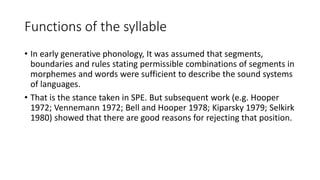The document discusses the functions and evidence for the syllable as a fundamental unit in phonology. It provides evidence from phonotactic distributions, phonological processes, and languages that show the syllable regulates permissible sound combinations and is the domain of many rules. The syllable also controls the structure of complex segments and allows abstract or "ghost" elements to influence rule application even if unpronounced.










![• [9.12] Illustrates the importance of constraints on the combination of
sounds. But, the sequences in [9.12] are not potential English words.
• The rules which reflect speakers' knowledge of what combinations of
sounds are allowed in their language are variously referred to as
PHONOTACTIC RULES or MORPHEME STRUCTURE CONDITIONS.](https://image.slidesharecdn.com/syllablestructurebadreddineibnyahia-220622205240-5fa4ef82/85/Syllable-Structure-pptx-11-320.jpg)
![• The syllable is the unit in terms of which phonotactic rules are best
stated.
• Thus, for instance, in English the sequence [tl] is allowed so long as
the t and the l belong to different syllables as in boot-leg [but-leg],
at-las [set-Is], part-ly [pat-ly] or litt-le [lit-l].
• Another English example of a phonotactic constraint is the rule which
only allows vowels to follow syllable-initial affricates: while cheap,
judge and adjust are English words, *chleep, *jpudge and *adjpudge
are neither real nor potential words in English.](https://image.slidesharecdn.com/syllablestructurebadreddineibnyahia-220622205240-5fa4ef82/85/Syllable-Structure-pptx-12-320.jpg)
![• Constraints on syllable structure serve as a filter allowing only certain
sound sequences to occur.
• These constraints are specific to a particular language.
• What is a well-formed syllable in Swahili may not be in English. In
Swahili (and in many other African languages) for instance, NC
sequences like [nd] as in [ndugu] 'brother' or [ɳg] as in [ɳguruwe] 'pig'
are allowed in syllable- (and word-) initial position but they are
outlawed in that position in English: *[ndu], *[mpig] and *[ɳget] are
not potential words in English.](https://image.slidesharecdn.com/syllablestructurebadreddineibnyahia-220622205240-5fa4ef82/85/Syllable-Structure-pptx-13-320.jpg)

![• In Turkish it is responsible for alternations like [rengi], (possessive),
[renkten] (ablative) and [renk] (nominative) 'colour'; in German for
the alternation between [tᾹk] 'day' and [tᾹgə] 'days'; in Russian for
the alternation between [gorat] 'town' and [garada] 'towns’.
• The rule can be written as follows:
• This rules misses the point that the environments 'word-finally' and
'before another consonant' are not accidentally related contexts. The
two environments share the property of being syllable final.](https://image.slidesharecdn.com/syllablestructurebadreddineibnyahia-220622205240-5fa4ef82/85/Syllable-Structure-pptx-15-320.jpg)
![• The nasalisation rule of French (which is similar to a nasalisation rule
found in numerous languages):
• The same nasalisation rule applies even where on the surface the
nasal is not syllable-final in words like sentiment [sᾹtimᾹ]
(sentimental [sᾹtimᾹtal] 'sentimental'); and grand [grᾹ] (grande
(feminine) [grᾹd]).](https://image.slidesharecdn.com/syllablestructurebadreddineibnyahia-220622205240-5fa4ef82/85/Syllable-Structure-pptx-16-320.jpg)
![• A derivation is worked out for grand:
• UR: /grand/
• Rule a
• Vowel nasalisation before syllable-final NC:
grand —> grᾹnd
• Rule b
• Consonant deletion:
grᾹnd —» grᾹ
• PR [grᾹ]
• (Note: rules a and b may apply simultaneously as the underlying
representation satisfies the structural descriptions of both rules.)](https://image.slidesharecdn.com/syllablestructurebadreddineibnyahia-220622205240-5fa4ef82/85/Syllable-Structure-pptx-17-320.jpg)



![• (b) Simultaneous association of one segment with two C or V slots.
• That is the case when consonants are GEMINATED or when a vowel is
lengthened. For example in [9.20]. The word ttaala [t:a:la] 'lamp', begins with
a geminate t followed by a geminate vowel.](https://image.slidesharecdn.com/syllablestructurebadreddineibnyahia-220622205240-5fa4ef82/85/Syllable-Structure-pptx-21-320.jpg)








![• Where the next word begins with a consonant as in petit prince
[9.50a], the floating underlying final /t/ of petit remains unattached
at the end of the derivation and consequently fails to surface.
• But where the next word begins with a vowel as in petit enfant
[9.50b], a C-element is inserted at the CV-tier and the floating
underlying /t/ is attached to it.](https://image.slidesharecdn.com/syllablestructurebadreddineibnyahia-220622205240-5fa4ef82/85/Syllable-Structure-pptx-30-320.jpg)
